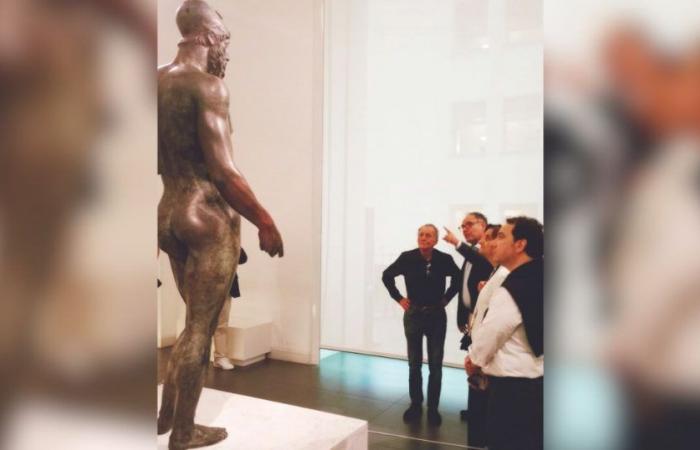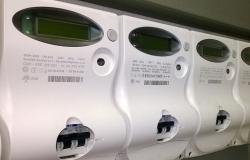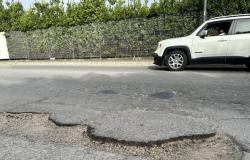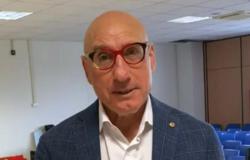The treasures we don’t know we have told during Roberto Vecchioni’s visit to the Marc in Reggio Calabria
“They seem to breathe”. The singer-songwriter-writer-poet Roberto Vecchioni gave us this splendid definition of Riace’s bronzesa few days ago at the Marc in Reggio. And his confession was surprising: “I’m seeing them for the first time”. The Latin and Greek professor over 80 is forgiven, even if he travels around Italy, even if the Bronzes are unique in the world, and he is a great classical preacher. “What I try to make people understand is that Greek and Latin are not exercises to be translated, but a world to be discovered”.
His visit and the presentation of his book were therefore a resounding victory in terms of communication (as will be the opening of the café-bistro on the Museum Terrace, in spite of all bureaucracy). But Vecchioni’s is perhaps a good opportunity to tell us about the treasures we have, and what is needed to make them a development resource. The Professor is the right testimonial: he knows poets who move rivers with their thoughts, he should be accompanied from the Sibaritide to the Strait, and then north to the Tyrrhenian Sea, in all the archaeological settlements that the researcher Fabrizio Mollo describes in his 750-page long Guide.
Except that the Professor would have to face the famous State Highway 106, and it’s not certain that he wants to. The journey could have a duration similar to those of the great explorers of the 19th century, on the back of a mule or in a carriage. A shame, because the museums are rich and welcoming. Because the work of directors such as Filippo Demma in Sibari, Elena Trunfio in Locri, Fabrizio Sudano and before Carmelo Malacrino in Reggio, is starting to have an impact in terms of visitors and attention.
But do we know that we have so much beauty? There is an Escher exhibition on tour in Italy: in Rome it was sold out, now it is in Ferrara. There are his photos and the diaries of a trip from almost a hundred years ago. The artist had his portrait taken in Scilla, Stilo, Pentedattilo: the background, the views are identical to today. His travel diary also includes Santa Severina, which continues to have one of the most beautiful squares in Italy.
Unattainable treasures. In Seminara, which graduates commonly remember as the town of feuds and the miter man, there is the Madonna degli Angeli by Antonello Gagini, in the church of San Marco (better to find out about openings). And the Pietà by the famous Renaissance sculptor breathes, as Vecchioni would say, in the church of Maria Addolorata in Soverato.
But put yourself in the shoes of a tourist who wants to get to, for example, the Locri Museum, the Ancient Theater, on the trail of this pearl of Magna Graecia that our ancestors defended better than us. The train arrives at the station, yes, but there are no shuttles (the topic of timetables is a separate page of the Quotidiano). By car from the Tirrenica you come across the Limina tunnel with work in progress, and on the Ionian there is the narrow 106 and the one-way bridge.
An integrated transport system should lead to faster and more frequent railway lines, not only to the advantage of the archaeological sites, at least until a minimum of traffic is re-established. More trains, fewer accidents, by the way. But that doesn’t happen, and cancellations are pouring in. Instead, it happens that a group of tourists who were supposed to take the private bus to Gerace were left at the Locri station because the driver had forgotten, it happened a few months ago.
Virtuous examples, instead: the intermodality experimented between the railway and the Roman Villa of Casignana (another unknown jewel), thanks to which hundreds of students were able to visit it, without arriving in droves on a bus, from the larger cities. Or also the test done with the Sibari Museum Link, from the station to the archaeological area, with four connections a day (on the other hand, the road that goes from Sibari to the Tarsia area has been under construction for 30 years).
In the end, it’s always worth it. Read what Sara Simeoni, an athlete-legend of Italian sports, wrote about her honeymoon: “So we chose a car trip to wander around without a pre-established plan, in absolute anarchy – we who were used to an existence marked by very rigid times – except for the final destination: Reggio Calabria with its Riace Bronzes. An itinerary between culture and cuisine, between masterpieces of art and gastronomy, a journey that however stopped in Gubbio, where we were blocked by a wave of ice and snow. The Riace Bronzes, no, we didn’t manage to see them. But I made up for it later, every time I passed through Reggio Calabria I always treated myself to a visit to the Museum where they are kept to take a look at them and say hello. As if they were two old friends”.
If I were director Sudano, I would invite you straight away. By the way, are we really sure that all the Calabrians have seen the Bronzes? Reluctants are forgiven: not everyone likes art, history and memory. But let’s not forget those who don’t like the sea, those who come in winter: another tourism is possible.






